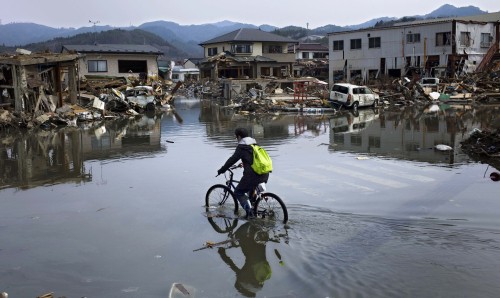TOKYO (AFP) - Japan may raise the severity of its nuclear accident to seven -- the top level on an international scale -- from five, the Kyodo news agency reported Tuesday, as workers battled to contain the crisis.
Kyodo said preliminary figures from the country's Nuclear Safety Commission revealed the battered Fukushima Daiichi nuclear plant had released up to 10,000 terabecquerels of radioactive materials per hour for several hours.
The calculation prompted Japan to consider upgrading the accident to the highest level -- something that has only be given to the 1986 Chernobyl disaster -- Kyodo said, citing unnamed government sources.
According to the INES, level 7 accidents release radioactive material of more than tens of thousands terabecquerels of radioactive iodine 131.
Haruki Madarame, chairman of the government-run commission, said it has estimated that the release of 10,000 terabecquerels of radioactive materials per hour continued for several hours, the report said.
Japan currently assesses the nuclear accident at level 5, or the same level as the Three Mile Island accident in the United States in 1979.
On Monday the disaster-stricken nation marked a month since the massive earthquake and tsunami hit northeastern Japan on March 11.
한글뉴스후쿠시마 원전사태, '레벨7'로 격상...체르노빌 수준
(도쿄=연합뉴스) = 일본 경제산업성 산하 원자력안전보안원은 12일
후쿠시마(福島) 제1원자력발전소 사고의 등급을 7등급으로 상향한다고 발표했다고 NHK 방송이 보도했다.
방송에 따르면 원자력안전보안원은 애초 사고 발생 직후 후쿠시마 원전 사고 등 급을 5등급으로 구분했으나 피해범위가 갈수록 넓어지고 대량의 방사성 물질이 방출 되고 있는 상황을 감안해 등급을 상향조정했다.
(AP) -- A strong new earthquake rattled Japan’s northeast Monday just hours after people bowed their heads and wept in ceremonies to mark a month since the tsunami that killed up to 25,000 people and set off a still-unfolding nuclear crisis.
The quake, the second major aftershock in less than a week, was another jarring reminder of the magnitude-9.0 earthquake that spawned the massive wave March 11. People in a large electronics store in Sendai screamed and ran outside and mothers grabbed their children, but there were no immediate reports of more damage or injuries.
Officials said operations were not endangered at the tsunami-flooded Fukushima Dai-ichi nuclear complex, where power was cut by the aftershock but quickly restored. Japan's meteorological agency measured the aftershock at a magnitude of 7.0, but a U.S.
monitor said it was 6.6. The epicenter of was just inland and about 100 miles (160 kilometers) north of Tokyo.
The Fukushima Dai-ichi plant is still leaking radiation after its cooling systems were knocked out by tsunami, and the government on Monday urged people in five additional communities near the plant to leave within a month, citing concerns about long-term health risks from radiation. People who lived within a 12-mile (20-kilometer) radius around the plant already have been evacuated.

A man rides a bicycle in the tsunami-hit prefecture of Miyagi in Japan on Monday. (Yonhap-AP)
With workers still far from bringing the plant under control, the bodies of thousands of tsunami victims yet to be found and more than 150,000 people living in shelters, there was little time for reflection on Japan's worst disaster since World War II.
People in hard-hit towns gathered for ceremonies at 2:46 p.m., the exact moment of the massive quake a month earlier.
``My chest has been ripped open by the suffering and pain that this disaster has caused the people of our prefecture,'' said Yuhei Sato, the governor of Fukushima, which saw its coastal areas devastated by the tsunami and is home to the damaged plant at the center of the nuclear crisis. ``I have no words to express my sorrow.''
In a devastated coastal neighborhood in the city of Natori, three dozen firemen and soldiers removed their hats and helmets and joined hands atop a small hill that has become a memorial for the dead.
Earlier, four monks in pointed hats rang a prayer bell there as they chanted for those killed.
The noisy clatter of construction equipment ceased briefly as crane operators stood outside their vehicles and bowed their heads.






